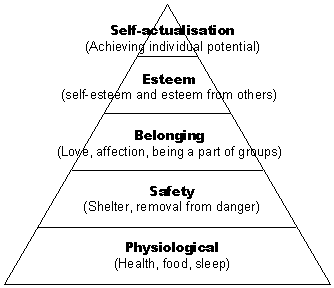|
Personal
Growth
By Suzanne E. Harrill
Recently, I looked online to review Maslow’s
Hierarchy of Needs. I was giving a talk and wanted to use
Abraham Maslow’s ideas to help others understand how important
it is to look at our needs when we want to discover what
motivates us. While in graduate school in the 1970’s, I was
introduced to Abraham Maslow as a personality theorist and liked
that he studied healthy people. His theory of human needs, first
presented in the early 1950’s, had five levels. At the bottom
of the pyramid were physiological needs, then moving up to
safety needs, next belongingness and love needs, next esteem
needs, and finally self-actualization needs. His theory, I
learned, was updated to include more detail. Following is a
brief synopsis of his theory, along with the updates.

Abraham Maslow used a pyramid to illustrate a
hierarchy of human needs based on two groupings: deficiency
needs and growth needs. Within the deficiency needs, each lower
need must be met before moving to the next higher level. Once
each of these needs has been satisfied, then, if at some future
time a deficiency is detected, the individual will act to remove
the deficiency. The first four levels that build on each other
are:
Physiological: air, food, drink, shelter,
warmth, sex, sleep, bodily comforts
Safety/security: protection, order, law,
limits, stability, out of danger
Belongingness and Love: family,
affection, relationships, affiliate with others, be accepted
and part of a group
Esteem: achievement, status,
responsibility, be competent, gain approval and recognition
According to Maslow, an individual is ready
to act upon the growth needs if, and only if, the deficiency
needs are met. Originally he included only one growth need –
self-actualization. Self-actualized people are characterized by:
(1) being problem-focused; (2) incorporating an ongoing
appreciation of life; (3) having a concern about personal
growth; and (4) being able to have peak experiences.
Later Maslow named two lower-level growth
needs prior to the general level of self-actualization (5 &
6) and one beyond that level (8). They are:
Cognitive: to know, to understand, to
explore, to find meaning
Aesthetic: appreciation and search for
beauty, balance, symmetry, order
Self-actualization: seek personal growth
and fulfillment, realize personal potential
Self-transcendence: to connect to
something beyond the ego or to help others to achieve
self-fulfillment and self-actualize.
It may be helpful in your self-exploration to
use Maslow’s Hierarchy of Needs to understand yourself and
others better. One example in being able to apply his theory may
be when you find yourself being overly self-critical for not
acting on some of your goals. Look at the level beneath your
current level of operation (level 4) to see if there is a
deficiency in love and support from others. If you are having
trouble in your marriage, the emotional disconnection may
contribute to your inability to meet your goals for esteem.
Working on your relationship to feel more safety (2) and
belonging and love (3) may help you find it easier to focus on
achievement or gaining recognition for your strengths and
talents. For more information Google Maslow’s Hierarchy of
Needs, as there are many sites with helpful information.
(Back)
|